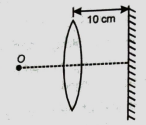A point object O is placed at distance 20 cm from a biconvex lens of radius of curvature 20 cm and =1.5. The final image produced by lens and mirror combination will be at

(1) 10 cm from the mirror
(2) 20 cm from lens
(3) -20 cm from lens
(4) -15 cm from the mirror

If the angle of a triangular prism is A and the refractive index of the material is , then under what condition will there be no emergent ray?
1.
2.
3.
4.
A thin lens whose power is +2D is cut into two pieces perpendicular to the principal axis. The focal length of each part will be
(1) 1 m
(2) 0.1 m
(3) 75 cm
(4) 0.05 m
A light ray is incident at an angle of on one face of a prism of a refractive angle . If light ray grazes the second face, then the refractive index of the material of prism is-
1.
2.
3.
4.
The near point of a hypermetropic eye is \(1~\text{m}.\)What is the power of the lens required to correct this defect?
1. \(-3~\text{D}\)
2. \(+3~\text{D}\)
3. \(+1~\text{D}\)
4. \(-1.75~\text{D}\)
The minimum magnifying power of an astronomical telescope is \(40\). If the length of the telescope is \(205\) cm, then the focal length of its field lens is:
1. \(5\) cm
2. \(200\) cm
3. \(40\) cm
4. \(140\) cm
A boy with defective eye-sight cannot see things beyond 50 cm. The corrective lens required has the power:
1. +1 D
2. +2 D
3. -1 D
4. -2 D
The focal lengths of the objective and eyepiece of a terrestrial telescope are 50 cm and 10 cm respectively. The magnifying power of the telescope when the final image is formed at infinity is
(1) 3.75
(2) -2.5
(3) -4.25
(4) +5
A convex mirror of focal length \(20~\text{cm}\) forms an image that is a quarter of the object's size. The distance of the object from the mirror is:
1. \(50~\text{cm}\)
2. \(-60~\text{cm}\)
3. \(-40~\text{cm}\)
4. \(-70~\text{cm}\)
The focal length of a thin convex lens for red and blue light is 0.5m and 0.484m. The dispersive power of the lens is
1. 0.984
2. 0.032
3. 0.484
4. 0.434






